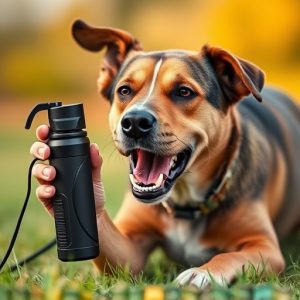Pepper Spray Defense: Legal Strategies for Dog Owners
The Pepper Spray Formulation Against Aggressive Dogs is a critical factor in evaluating its legal de…….
The Pepper Spray Formulation Against Aggressive Dogs is a critical factor in evaluating its legal defense as a self-protection tool. Capsaicin, the key ingredient, binds to dog pain receptors, causing temporary incapacitation. Formulations like oleoresin capsicum (OC), water, and additives ensure potency while maintaining user and animal safety. Legal frameworks vary across jurisdictions, regulating who can carry and use pepper spray, with many recognizing its efficacy as a non-lethal deterrent. Understanding local laws, scrutinizing pre-incident circumstances, and challenging the validity of pepper spray usage are crucial for a robust defense strategy. Real-world case studies demonstrate pepper spray's effectiveness in deterring and escaping dog attacks, supporting its legality and usefulness as a personal defense option.
In today’s world, understanding the efficacy and legal implications of pepper spray for self-defense against aggressive dogs is paramount. This article delves into the intricate details of pepper spray formulation specifically tailored for canine aggression, exploring its effectiveness and safety. We dissect the legal framework surrounding dog spray use, empowering individuals to safeguard their rights. Furthermore, we provide strategic defenses against potential lawsuits and present real-world case studies, offering insights into the success of pepper spray as a defensive measure for responsible pet owners.
- Understanding Pepper Spray Formulation and Its Efficacy Against Aggressive Dogs
- Legal Framework Surrounding Dog Spray Use and Self-Defense Rights
- Building a Strong Defense: Strategies for Challenging Dog Spray Lawsuits
- Real-World Case Studies: Examining the Success of Pepper Spray as a Defensive Measure
Understanding Pepper Spray Formulation and Its Efficacy Against Aggressive Dogs
Understanding the pepper spray formulation and its efficacy against aggressive dogs is key to evaluating its legal defense as a tool for self-protection. Pepper spray, also known as oleoresin capsicum (OC), is designed to disrupt an animal’s sensory perception by targeting the eyes, nose, and throat. The active ingredient, capsaicin, binds to pain receptors, causing a burning sensation that can temporarily incapacitate the dog, giving the user time to retreat or seek help.
The formulation of pepper spray varies among brands, but it typically consists of a mixture of OC, water, and various additives like UV stabilizers and preservatives. These formulations are specifically tailored to balance potency with safety for both users and animals. Studies have shown that when used appropriately, pepper spray can be an effective deterrent against aggressive dogs, offering a non-lethal means of self-defense in situations where other methods may not be feasible or safe.
Legal Framework Surrounding Dog Spray Use and Self-Defense Rights
The legal framework regarding dog spray use for self-defense is a complex issue, varying across jurisdictions. In many regions, citizens have the right to protect themselves from aggressive or dangerous dogs, and pepper spray (or mace) is often recognized as a legitimate deterrent and defense tool in such situations. The specific regulations dictate who can carry it, under what circumstances, and which types of pepper spray formulations are permitted.
For instance, some areas classify dog spray as a weapon and have stringent rules on its possession and use. These laws may require individuals to undergo training or obtain special licenses to carry and deploy such devices. The focus is often on ensuring the safety of both citizens and animals by regulating the responsible use of pepper spray formulations designed to subdue aggressive dogs without causing permanent harm.
Building a Strong Defense: Strategies for Challenging Dog Spray Lawsuits
When facing a lawsuit related to dog spray usage, building a robust defense strategy is paramount. The first step involves understanding the specific laws and regulations governing pepper spray deployment against aggressive dogs in your jurisdiction. Legal teams should scrutinize the circumstances leading up to the incident, focusing on factors like the behavior of the dog, the reasonableness of the force used, and any potential alternative responses.
A strong defense can challenge the validity of the lawsuit by examining the pepper spray formulation’s effectiveness and safety. This includes providing evidence that demonstrates the spray was a proportional response to the dog’s aggression and that it adheres to industry standards. Additionally, legal experts may argue for immunity based on protecting public safety or cite precedents where similar measures were deemed lawful.
Real-World Case Studies: Examining the Success of Pepper Spray as a Defensive Measure
In real-world scenarios, pepper spray has proven itself as a powerful and effective defensive tool against aggressive dogs. Numerous case studies illustrate successful instances where individuals have used pepper spray to deter and escape from dog attacks, showcasing its potential as a non-lethal self-defense mechanism. These cases often highlight the unique Pepper Spray Formulation Against Aggressive Dogs, which is specifically designed to disrupt a dog’s sensory perception without causing severe harm.
The success stories involve various scenarios, from individuals facing off against large, unprovoked attacks to people protecting themselves in their homes from persistent dog intruders. In many of these cases, the swift application of pepper spray has enabled victims to escape safely, demonstrating its ability to neutralise the threat posed by aggressive canine behavior. Such real-world evidence reinforces the argument for the legality and usefulness of pepper spray as a personal defense option, especially when facing unpredictable and potentially dangerous dog encounters.
The legal and practical considerations surrounding pepper spray as a defense against aggressive dogs are complex. Understanding the specific formulation and its effectiveness, navigating the legal framework, and employing robust defensive strategies are key to ensuring its legitimacy as a self-defense tool. Real-world case studies highlight its successful application in various scenarios, emphasizing the importance of informed use and strategic legal defense. By exploring these aspects, individuals can better protect themselves and their rights when facing potentially dangerous canine encounters.


